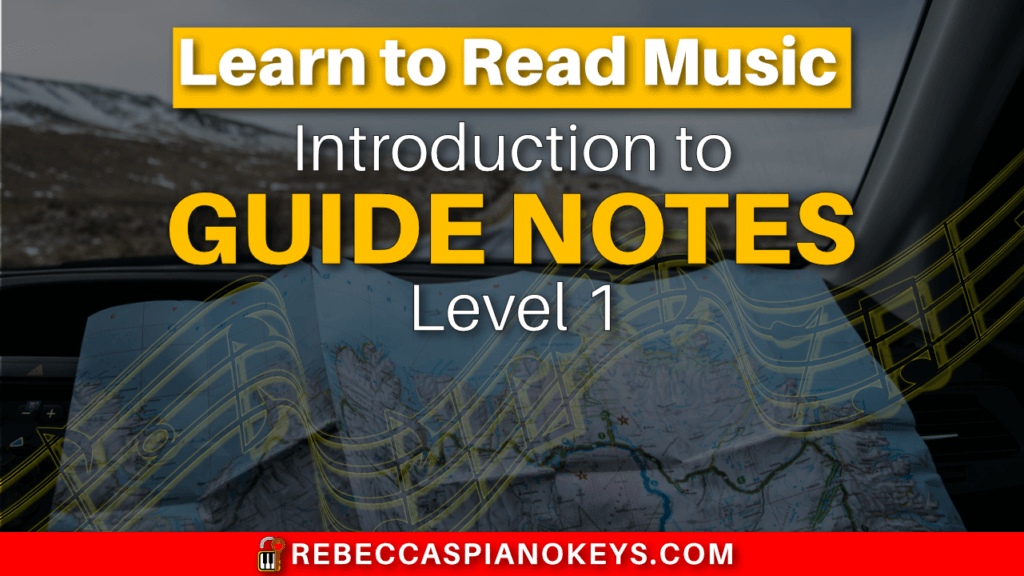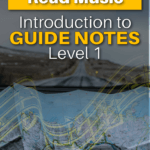Last Updated on June 1, 2022 by Rebecca
One of the best ways to learn to read music is to use the guide notes system, also called the landmark notes system.
The guide notes system encourages you to become extremely familiar with a few specific notes, so you can then recognize any nearby notes in terms of how close they are to one of your guide notes (aka landmark notes).
There are 3 sets of guide notes to learn. This post will focus on the first set.
Knowledge You Need Before You Read this Post
If you haven't already memorized the layout of the keys on your piano, you'll want to head over to this post and learn that first.
And if you're not yet familiar with the basics of how the music staff works (ex: what the treble and bass staves are, the difference between a line note and a space note, etc.), you'll want to head over to this post and learn that as well.
Connecting the Staff to Your Piano Keys
What's significant about the guide notes system, is that unlike the old acronym system (Every Good Boy Deserves Fudge), this system has a stronger focus on connecting the notes to the physical keys on the piano.
With the acronyms system, it can be easy to end up in a position where you've thoroughly memorized all the notes on the staff, but you have no idea which keys they correspond to on your piano.
You can find yourself thinking, “I know the 4th line of the treble clef is a D, but which D is it on the piano?”
So with that said… let's dive in and learn the first 3 guide notes!

Learning Your First 3 Guide Notes (Landmark Notes) on the Grand Staff
The first 3 guide notes you want to learn are middle C, treble G, and bass F.
This post explains in detail why these 3 notes are so significant on the music staff, but the short version is this:
- Middle C is the middle note that exists between the bass staff and the treble staff.
- Treble G is marked by the inside curl of the treble clef.
- Bass F is marked by the 3 dots of the bass clef.
Because bass F and treble G are marked by the clefs, practicing drawing treble clefs and bass clefs can actually help you learn to read music because it can help to reinforce the location of these two guide notes for you!
Another way to remember these guide notes on the staff (if you don't want to refer back to the clefs) is to count lines on the staff:
- Middle C floats above the bass staff, or below the treble staff, with a ledger line running through it.
- Treble G is 2 lines above “middle C's playground.”
- Bass F is 2 lines below “middle C's playground.”

The only tricky part is remembering which one is F and which one is G. Visualizing them on the piano keyboard can help with this, but really, you just have to put in the effort to memorize it.
Learning Your First 3 Guide Notes (Landmark Notes) on the Piano
Older method books typically started students with their hands in middle C position.
This is still common some modern method books, but it's no longer standard to all method books. Many method books focus on other 5-finger positions.
I'm no longer a fan of middle C position or any other 5-finger fixed positions (more on that in a future post), but middle C position will nevertheless provide a good visual to help you see where your first 3 guide notes lie on the keys.
To play in middle C position, place your 2 thumbs together on middle C (yes, it's a tight fit!) and let the rest of your fingers fan out, one on each key moving out from middle C.
In this position, your thumbs are on middle C (your first guide note or landmark note), your right pinky (RH finger 5) is on treble G, and your left pinky (LH finger 5) is on bass F.

So when you place your hands in middle C position, the guide notes are marked by your thumbs and pinky fingers.
Connecting Level 1 Guides Notes (Landmark Notes) on the Grand Staff and the Piano Keyboard

Practicing the Level 1 Guide Notes (Landmark Notes)
Now it's all well and good to understand what the first 3 guide notes are, but feeling comfortable and confident at the piano is all about ease of recall.
You need to be able to recognize these guide notes instantly, without any effort.
Personally, I believe composing is one of the best ways to learn to read music. So I have a book coming out soon that walks you through several composing exercises that will help you master your first 3 guide notes and become a confident and competent note-reader.
But in the meantime, you can start by drilling the guide notes with these Level 1 Guide Note Flash Cards, and you can download a simple 1-page Level 1 Guide Notes Cheat Sheet if you'd like a quick visual reference.
Ready to Really Build Your Confidence Reading Music?
If you're interested in a more intensive resource to help you build confidence reading music using the guide notes system, you'll love my workbook Learn to Read You Own Music Book 1.



